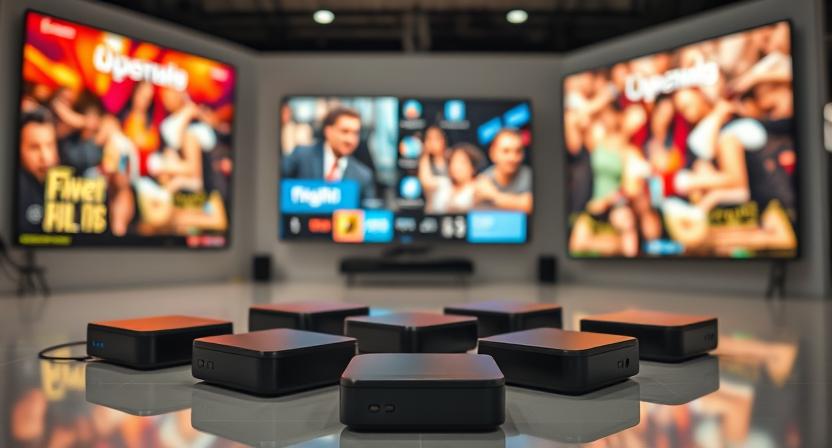How Android Boxes Streamline Advertising Network Management
In the digital era, advertising has evolved into a connected ecosystem that spans cities, countries, and continents. Managing such vast networks of displays requires advanced technology that offers real-time control, scalability, and automation. The Android Box for Advertising has emerged as the perfect solution for managing large-scale digital signage networks, providing centralized oversight, efficient content delivery, and data-driven performance tracking.
1. The Challenge of Modern Advertising Networks
Traditional digital signage systems often face challenges related to content synchronization, remote updates, and device maintenance. As networks expand, these challenges multiply, leading to inefficiencies and increased operational costs.
To address these issues, businesses are adopting Android-based systems, which offer greater flexibility and cloud integration capabilities, allowing advertisers to control hundreds—or even thousands—of displays simultaneously.
2. Centralized Control Through Android Systems
One of the biggest advantages of the Android Box for Advertising is centralized management. Using cloud-based control platforms, administrators can distribute content, monitor device performance, and schedule updates remotely.
Real-time dashboard visibility for all connected devices.
Automated error detection and system alerts.
Multi-user access and permission management.
Global synchronization of campaigns across regions.
This unified approach drastically simplifies advertising network management for enterprises operating across multiple geographic locations.
3. Automation and Smart Scheduling
Manual content updates are time-consuming and prone to error. With digital advertising automation, Android-based networks allow operators to schedule campaigns based on time, audience demographics, or event triggers.
For example, a retailer can automatically display breakfast ads in the morning and switch to lunch promotions at noon without any human intervention. This automation reduces administrative workload while ensuring accurate, timely content delivery.
4. Real-Time Monitoring and Remote Diagnostics
System reliability is crucial for network success. Through built-in monitoring tools, the Android Box for Advertising continuously reports operational data such as device uptime, content playback logs, and connection status.
IT teams can remotely diagnose issues, reboot devices, or push firmware updates without physical maintenance. This proactive management minimizes downtime and ensures uninterrupted advertising performance.
5. Seamless Integration with Content Management Systems (CMS)
Modern android signage control platforms integrate seamlessly with existing CMS frameworks. Advertisers can design, upload, and deploy content through drag-and-drop interfaces while Android boxes handle playback intelligently across various screen types and resolutions.
These CMS integrations support multi-format compatibility, making it easy to combine video, image, and dynamic HTML content within the same campaign.
6. Cloud-Based Network Architecture
At the heart of efficient advertising management lies the cloud. The Android Box for Advertising leverages cloud computing to store media assets, log analytics, and manage devices remotely.
By centralizing data, advertisers gain instant access to campaign insights, playback history, and audience metrics from anywhere in the world. This global connectivity is especially valuable for brands operating across multiple time zones or managing franchises under unified marketing strategies.
7. Scalability and Network Expansion
Android’s modular ecosystem makes scaling simple. Adding new screens or locations to an existing network is as easy as connecting a new Android box to the system and registering it through the management portal.
This plug-and-play capability allows businesses to expand their smart ad distribution infrastructure without complex configurations or costly hardware replacements.
8. Security and Access Control
Data security is a top priority in large-scale advertising networks. The Android Box for Advertising includes enterprise-grade encryption, secure communication protocols, and role-based access control.
Administrators can define user roles, monitor login activity, and restrict sensitive operations such as firmware modifications or content overrides. These safeguards ensure that each network remains compliant, stable, and tamper-proof.
9. Advanced Analytics and Reporting
Modern advertisers demand measurable outcomes. Android systems offer built-in analytics to track campaign effectiveness, viewer engagement, and playback performance.
By integrating AI analytics, advertisers can interpret viewer demographics, screen interaction frequency, and conversion data. These insights empower businesses to fine-tune campaigns and allocate budgets more efficiently across multiple channels.
10. Cost Efficiency and Operational Simplicity
Compared to traditional PC-based signage systems, Android boxes offer significant cost advantages. They are compact, energy-efficient, and require minimal maintenance. Their open-source framework eliminates licensing fees, reducing total cost of ownership (TCO) while maintaining high performance.
This affordability allows small and medium enterprises to build professional-grade networks with the same features as multinational corporations.
11. Real-World Application Examples
Enterprises across various industries are already leveraging Android-based advertising network management to streamline operations:
Retail Chains: Centrally managed price updates and localized promotions.
Transportation: Dynamic route information and real-time digital ads in bus terminals.
Hospitality: Digital welcome screens and automated event promotions.
Healthcare: Automated appointment reminders and educational video signage.
These implementations highlight how Android-powered automation bridges technology, marketing, and audience engagement efficiently.
12. The Future of Networked Advertising
As networks evolve, the Android Box for Advertising will continue integrating AI, IoT, and cloud intelligence to create fully autonomous ad ecosystems.
Predictive analytics will allow systems to automatically adjust campaigns based on performance trends, while voice and gesture control will redefine interactivity. The future lies in networks that self-optimize, delivering the right message at the right moment, every time.
Conclusion: Smarter Management for Smarter Advertising
The convergence of automation, cloud connectivity, and AI has redefined how businesses manage digital advertising networks. With the Android Box for Advertising, companies can achieve seamless control, enhanced efficiency, and measurable ROI across every screen.
Looking to simplify your advertising network management? Contact our Android signage experts today to discover scalable, intelligent solutions that streamline control and maximize marketing performance.
READ MORE
How Android Boxes Elevate Interactive Advertising Experiences
Why Android Boxes Are Essential for Next-Gen Advertising Platforms
How Android Boxes Drive Innovation in Smart Advertising Systems
The Impact of Android Boxes on Interactive Advertising Experiences
Enhancing Retail Engagement with Android Box for Advertising
How Android Boxes Enable Smarter, Data-Driven Advertising Displays
The Role of Android Boxes in Transforming Digital Signage Advertising
How Android Boxes Power the Future of Smart Advertising Displays
Quick Links





.png)
.png)






.png)

.png)














